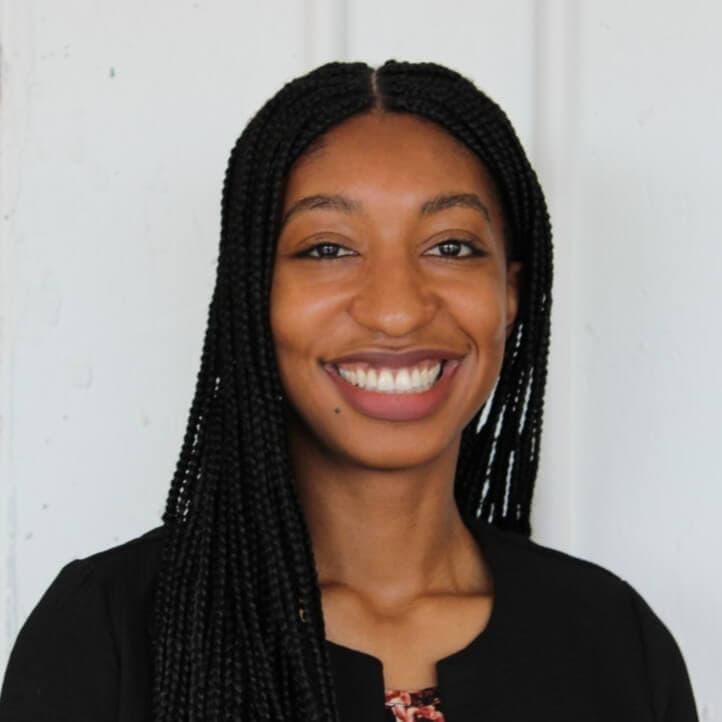I contemplated leaving Boston at the height of the pandemic when so many of my friends left the city for exotic locales. Like many Bostonians, I turned to gardening and green spaces in a time of crisis. After immersing myself in community gardens and having just settled my own seeds into the soil, something peculiar happened. I, too, felt rooted. This moment of connection reminded me that I was in fact living in a place, closely dependent on the natural world, even though I was confined indoors. Gardening forced me to stick around, but it also held space to ask questions. In a city still contending with segregation, I wondered why the public spaces I so enjoy don’t reflect Boston’s broader communities of color. As it turns out, I wasn’t alone. For artists Ekua Holmes and Elizabeth James-Perry, those questions reveal the absence of authentic representations of Boston’s Black and Indigenous communities. “Garden for Boston,” comprising two installations situated on the lawn of the Museum of Fine Arts—Holmes’s Radiant Community, featuring 3,000 sunflowers, and James-Perry’s Raven Reshapes Boston: A Native Corn Garden at the MFA—intervenes with an alternative. What began as a spirited “Table of Voices” discussion about the artworks on the museum’s plaza grew into aspirations from Holmes and James-Perry to reclaim the land itself. In conceiving of her installation, James-Perry recounts, “There’s a real lack of any palpable Native presence in the layout of [Boston], which is troubling to myself and many Native people.” In “Garden,” James-Perry and Holmes combine their diverse set of artistic practices to excavate lost connections between the Black and Native communities. As James-Perry says, “Gardens sustained both of our communities and keep you mindful of the abundance around you.” James-Perry’s practice entails working with natural dyes, handmade textiles, and jewelry in the early Northeastern Woodlands tradition. An enrolled member of the Aquinnah Wampanoag tribe—a community with a long history of harvesting the sea—James-Perry is also a marine biologist. Her commitment to Indigenous storytelling is especially apparent in her beadwork, where whales, seals, otters, and other sea creatures with rich cultural meaning feature prominently. In addition to Raven Reshapes Boston, James-Perry created a wampum belt in commemoration of this project, currently on view in the museum. Both artists are deeply embedded in their communities and wanted “Garden” to be a collaborative effort. Community members were invited to assist in the planting and will be welcomed back for harvests throughout the fall.
Issue 07 • Oct 24, 2021
The Radical Act of Growing a Plant: Garden for Boston at the MFA
What began as a spirited “Table of Voices” discussion about the artworks on the museum’s plaza grew into aspirations from Holmes and James-Perry to reclaim the land itself.
Review by Paige Curtis
Ekua Holmes planting pollinator perennials around the site for Radiant Community in May 2021. Photo © Museum of Fine Arts, Boston.
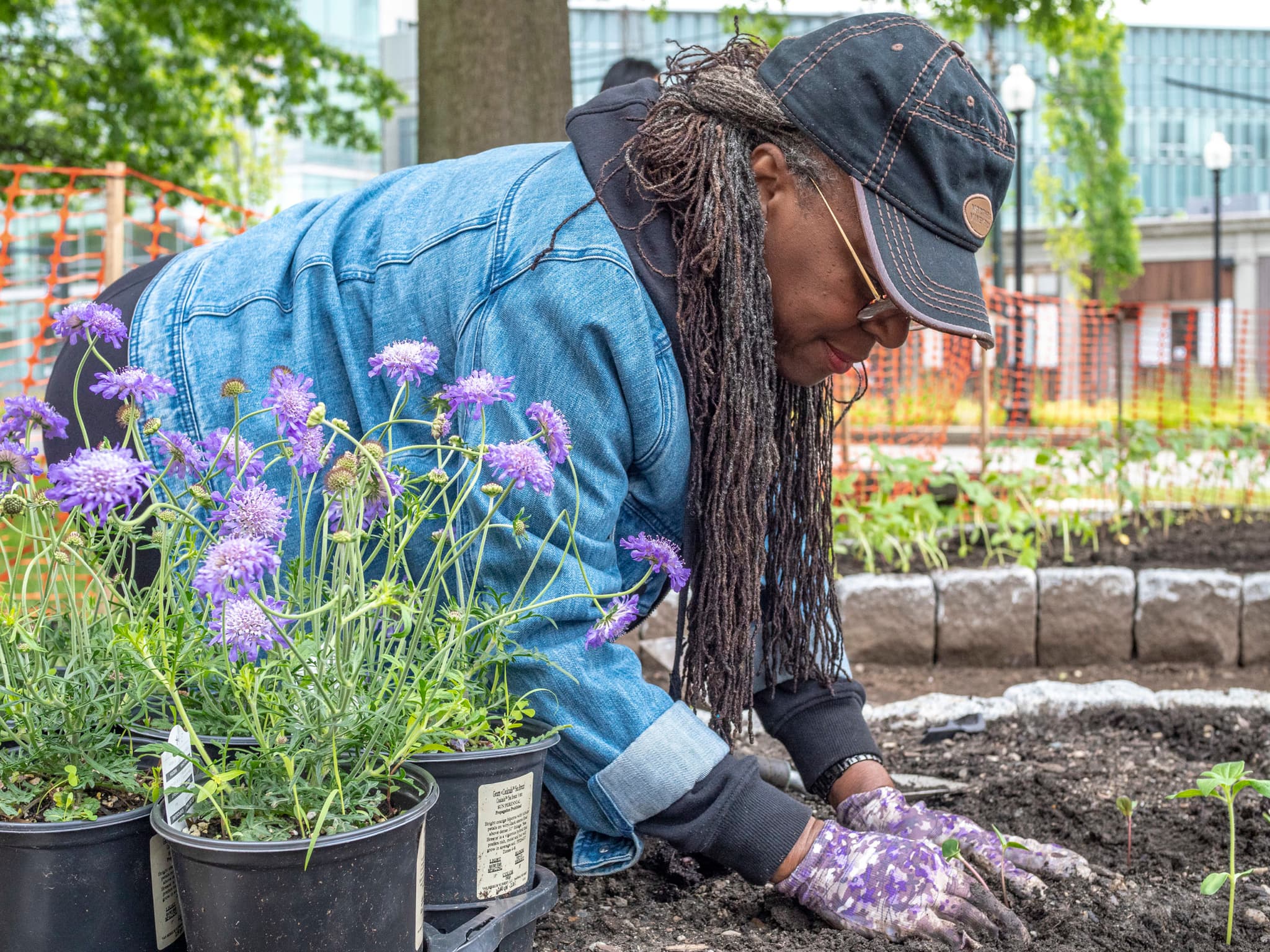
Ekua Holmes planting pollinator perennials around the site for Radiant Community in May 2021. Photo © Museum of Fine Arts, Boston.
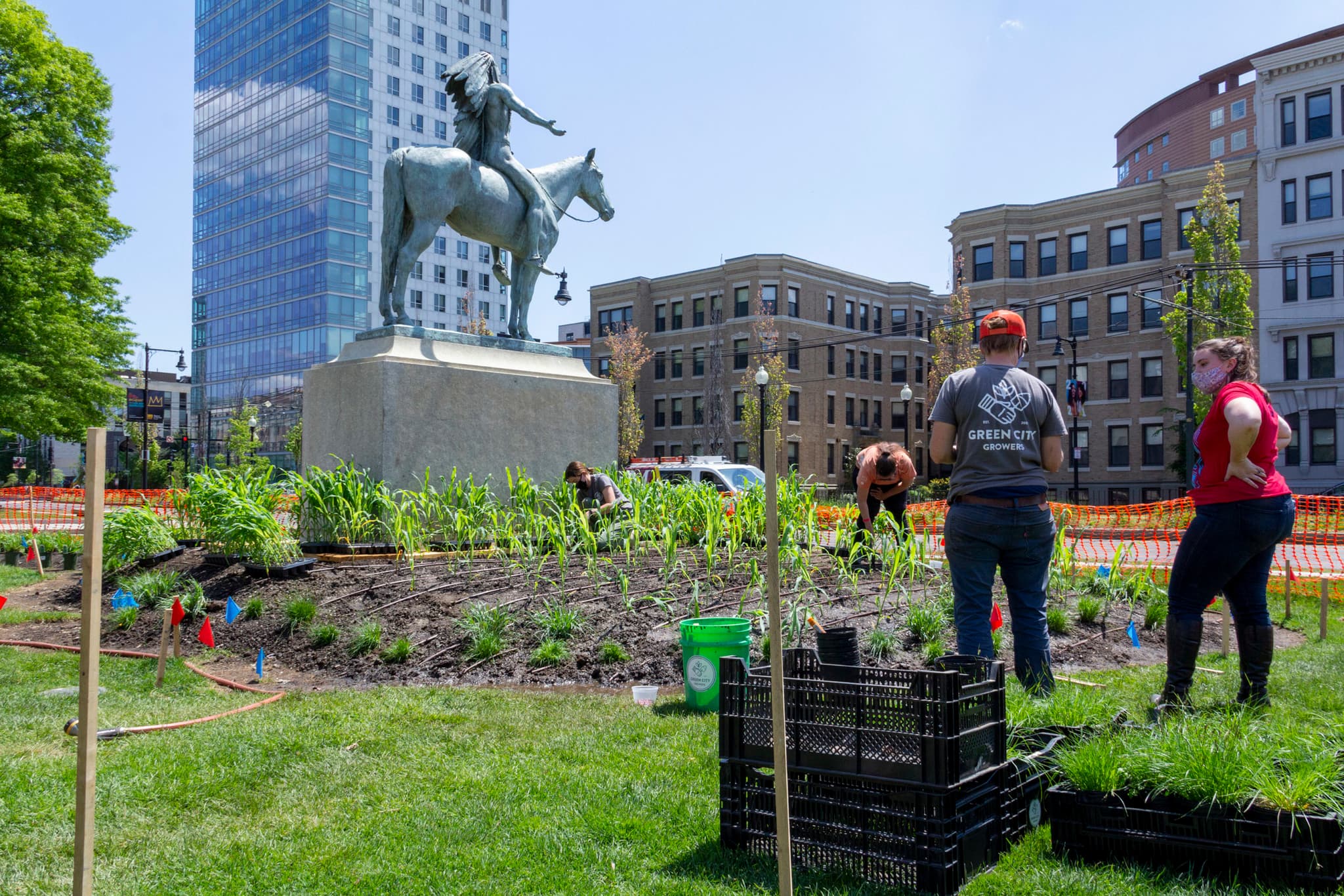
Elizabeth James-Perry and her team planted a Three Sisters garden around Cyrus Dallin’s Appeal to the Great Spirit for Raven Reshapes Boston: A Native Corn Garden. Photo © Museum of Fine Arts, Boston.
Holmes finds inspiration in her own backyard; working primarily in mixed media collage and illustration, she invokes childhood memories, family histories, and decisively Black imagery. “Paper Stories, Layered Dreams: The Art of Ekua Holmes,” which is currently on view inside the MFA, is the first museum survey of Holmes’s award-winning illustrations for children’s books. Here, her works are alive with rich color palettes and unapologetic joy. Just outside the museum’s marble colonnades, Radiant Community flourishes as a grand extension of her personal and community-based practice. Her Roxbury Sunflower Project, which distributes 10,000 sunflower seeds to Roxbury residents annually, grew out of a desire to bring beauty back to neglected spaces across the city. Holmes has long dreamt of Roxbury awash in a sea of sunflowers—a testament to the beauty and resilience of the neighborhood she grew up in. For Radiant Community, Holmes collaborated with United Neighbors of Lower Roxbury Community Gardens’ co-caretakers, London Parker McWhorter who shares planning and project management duties with his mother, Lolita Parker Jr.
There is no wrong way to experience “Garden for Boston,” but I recommend a visit during golden hour. Against the backdrop of a conventional grass lawn, Raven Reshapes Boston is a welcome relief in movement and dimension. James-Perry marries corn, beans, and sedge grass atop a raised mound, drawing on the Native tradition of Three Sisters companion planting, whereby corn, beans, and squash are grown alongside each other to facilitate their symbiotic relationship. “As an island person living on Noepe [Martha’s Vineyard], I also wanted to include the quahog shells and horseshoe crab shape for their connections to the ocean,” James-Perry explains. “The elevated bed adds some dimensionality, changing the energy of the space, and harkens back to traditional Indigenous earthworks.” The tassels and stalks of the corn careen in unison with the right breeze, and suddenly something as familiar as corn seems otherworldly.
It takes several viewings to wade through the layers of meaning in both installations, and “Garden” succeeds at inviting reflection. Sitting with the 3,000 sunflowers planted in Radiant Community, I can’t help but feel enchanted by their human-like qualities. On my last visit, the sunflowers, being heliotropic and often in search of sun, faced the museum steps in a sort of salute. “There’s so much diversity within the sunflower, and we planted about seven varieties,” Holmes points out. “We also wanted people to access the planting, so we included cobblestones—something my aunt did in her garden.” Sunflowers are known to send down a deep taproot, anchoring through in the toughest conditions. With their resplendent color and ability to transform the very soil they’re planted in, I struggle to think of a better symbol for Roxbury’s resilience. Undergirding Holmes’s work is the notion that beauty is a basic service, and indeed, both installations are just damn delightful to look at.
The magic of the exhibition lies in its dynamism; it is in constant conversation with the activity around it. The natural materials in “Garden” convey scent, color, and fluidity with the changing seasons. Commuters and students rushing by on the train or on foot may catch a glimpse of the garden, but those seeking a reprieve from the brutal linearity of the city might linger. The interactions born from this final element of the artwork—people—make every visit special. “Garden” reminds us why gardening is so artful; it collapses the dichotomy between form and function. Growing plants provides an aesthetic service, while the act of growing plants for sustenance satisfies both nourishment and a sense of connection to the bounty of earth. Whatever the purpose for planting a seed, the eruption of life that follows is a rare kind of alchemy.
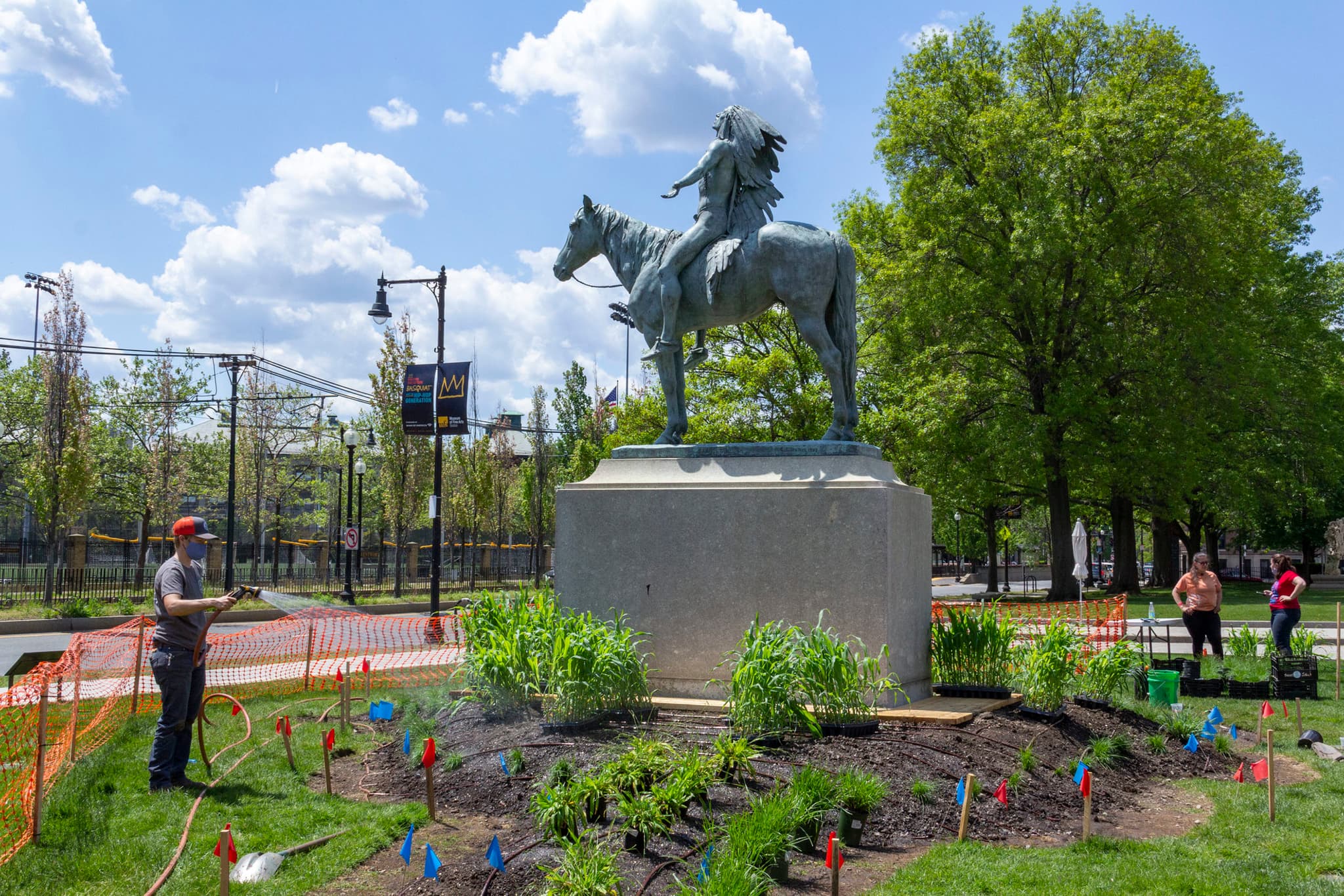
At their peak, the corn stalks would grow to cover the granite base of Appeal to the Great Spirit. Elizabeth James-Perry and her team planted in May for expected harvest by the end of summer. Photo © Museum of Fine Arts, Boston.
Bostonians often forget that the MFA resides near Roxbury—and on the homeland of the Massachusett people. The museum is only beginning to engage with the complicated history of works like Appeal to the Great Spirit. Occupying the MFA’s front lawn, this statue by Cyrus Dallin depicts a Native man atop a horse with his arms sprawled open. Drawing on stereotypes, clad in a mishmash of regalia from distant Native nations, the statue grossly disappears local Wampanoag and Massachusett people. Raven Reshapes Boston is, in part, a response; Radiant Community is also a counterproposal, asserting the beauty of a neighboring community now facing rampant gentrification.
When I last visited the exhibition, a man that I’ll call Michael shared fond memories of passing by the sculpture on his commute to Boston University. He shared thoughts on the Native figure and concluded, “But what does my opinion matter? I’m just a white guy.” Michael spoke from the belief that on matters of race, the opinions of white people aren’t important because they aren’t as marginalized. But the opinion of white men like Michael still holds disproportionate power, and it’s likely the reason that the sculpture was erected in the first place. When 85 percent of artists exhibited in major US museums are white, and 87 percent are men, women artists of color deserve more recognition; the work of Holmes and James-Perry demands that. In “Garden,” Black and Indigenous perspectives finally take center stage.
Members of the curatorial staff admit to being challenged by “Garden,” in the best possible way. The conversations sparked around centering marginalized voices, in the exhibition and the public programs leading up to its grand opening, highlighted the intersections between Black and Indigenous history. Both works in “Garden for Boston” resist a dominant narrative, but how can ephemeral art atone for such enduring exclusion?
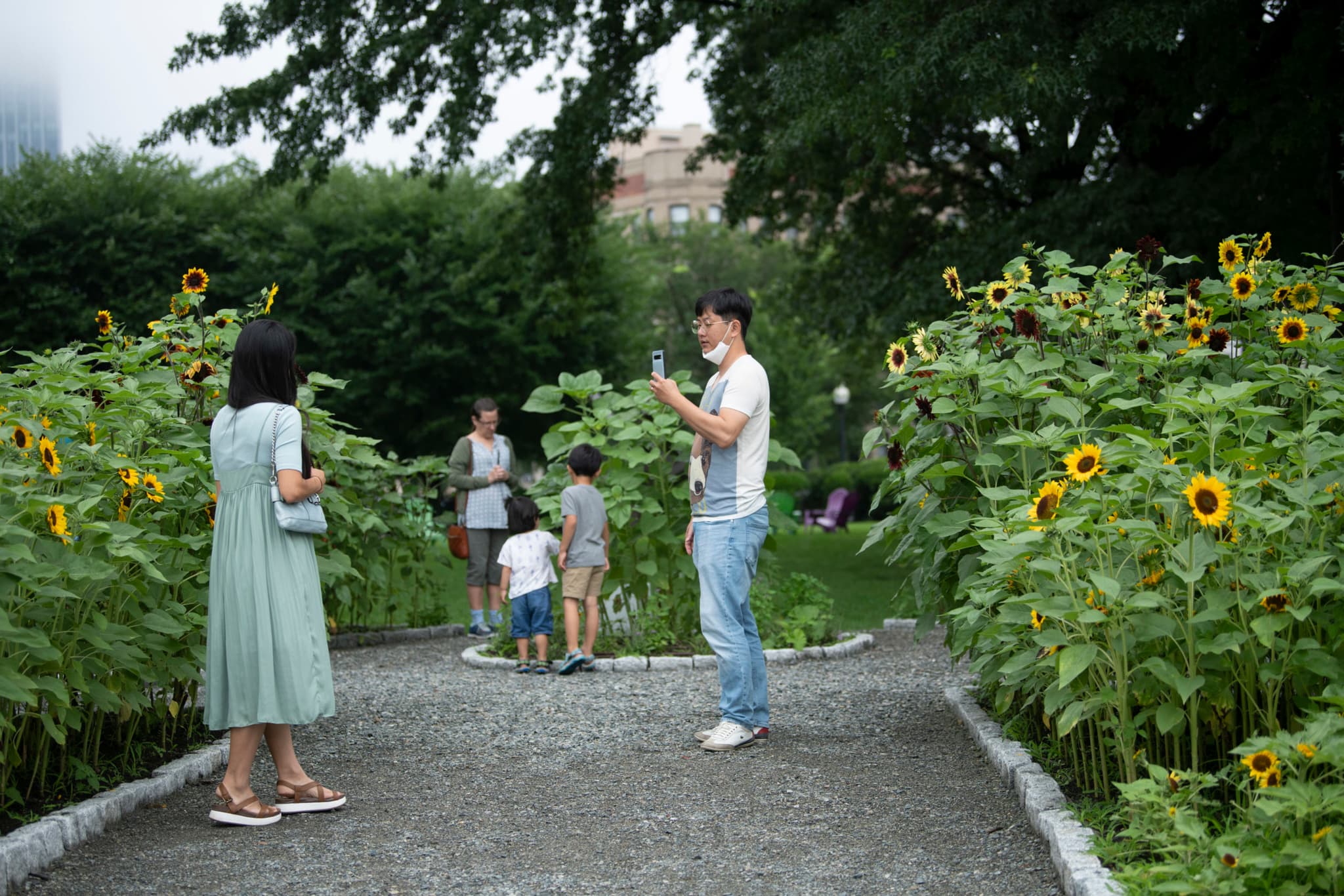
By July, visitors to Radiant Community could experience thousands of sunflowers beginning to tower overhead. Holmes’s installation at the Museum of Fine Arts became an extension of her annual sunflower planting around Roxbury. Photo by Tony Rinaldo Photography © Museum of Fine Arts, Boston.
A billboard adjacent to the exhibit offers some resolution, calling viewers to “reclaim. repair. revive.” “Garden for Boston” is undeniably an act of reclamation. Passersby now have reason to ask why there is a Native corn field on the border of lower Roxbury and demand more of the public monuments in the state’s capital. Any gardener knows that restoration takes time, but James-Perry proves that leaving a legacy can be a reparative act. “I’m probably the first Wampanoag person to garden here in a long time. I want my descendants to look back on this and see how much people cared.” Holmes and James-Perry are two women artists of color negotiating futurity while correcting misconceptions about their forebears. Holmes—inspired by the work of Alice Walker and Fannie Lou Hamer—reminds us, “The creative force in marginalized women doesn’t go away. My mother’s garden was an incredible place that enlivened the community.”
“Garden for Boston” is a container for remembrance, but more importantly it is a living memorial. Unlike a fixed statue doomed to weather time and changing opinion, gardens require an ongoing commitment and care. Akin to planting flowers in one’s front yard, the exhibition is a love letter to Boston in the most inclusive sense and an invitation to show up for the natural world. “Planting flowers may not seem revolutionary, but a seed can also be an idea. This project is a seed that the MFA will nurture in partnership with the community,” Holmes says. I can’t wait to see what blooms.
“Garden for Boston” was on view at the Museum of Fine Arts through October 12. “Paper Stories, Layered Dreams” will be on view through January 23, 2022.
This feature was originally published in Issue 07: Rooting, which was released in October 2021. The print version contains additional photos.
